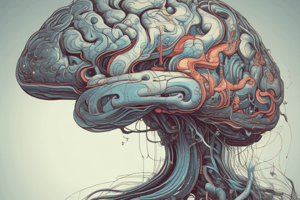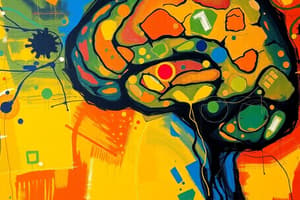Podcast
Questions and Answers
What is the primary role of the amygdala in fear conditioning?
What is the primary role of the amygdala in fear conditioning?
- The amygdala is responsible for the conscious experience of fear, allowing individuals to recognize and label their emotions.
- The amygdala is responsible for the physiological responses to fear, such as increased heart rate and sweating.
- The amygdala is involved in the association of neutral stimuli with aversive experiences, leading to the development of conditioned fear responses. (correct)
- The amygdala plays a role in the expression of facial expressions associated with fear, specifically the Duchenne smile.
Which of the following is NOT a key structure within the amygdala?
Which of the following is NOT a key structure within the amygdala?
- Basolateral nuclei (BLA)
- Mediodorsal nucleus of the thalamus
- Central nucleus (CeA)
- Hippocampus (correct)
In the context of emotional expression, what is the difference between a pyramidal smile and a Duchenne smile?
In the context of emotional expression, what is the difference between a pyramidal smile and a Duchenne smile?
- A pyramidal smile is more symmetrical than a Duchenne smile.
- A Duchenne smile is more likely to be associated with positive emotions than a pyramidal smile.
- A pyramidal smile is involuntary, while a Duchenne smile is voluntary.
- A pyramidal smile is associated with genuine emotions, while a Duchenne smile is a forced or social expression. (correct)
Which of the following brain regions is NOT considered part of the limbic system?
Which of the following brain regions is NOT considered part of the limbic system?
How do NMDA antagonists affect fear conditioning?
How do NMDA antagonists affect fear conditioning?
What is the significance of the highly interconnected nature of the amygdala?
What is the significance of the highly interconnected nature of the amygdala?
What is the difference between cued fear conditioning and contextual fear conditioning?
What is the difference between cued fear conditioning and contextual fear conditioning?
What is a common characteristic observed in patients with post-traumatic stress disorder (PTSD)?
What is a common characteristic observed in patients with post-traumatic stress disorder (PTSD)?
What is the primary function of the visceral motor system?
What is the primary function of the visceral motor system?
Which of the following is NOT a characteristic of the sympathetic nervous system?
Which of the following is NOT a characteristic of the sympathetic nervous system?
Flashcards
Role of Emotions in Behavior
Role of Emotions in Behavior
Emotions guide behavior by associating feelings with positive actions, crucial for learning.
Disrupted Emotions
Disrupted Emotions
Conditions like depression, anxiety, and phobias disrupt normal emotional responses.
Subjective Emotion
Subjective Emotion
An emotion is a personal feeling defined by valence (pleasantness) and intensity (strength).
Visceral Motor System
Visceral Motor System
Signup and view all the flashcards
Autonomic Nervous System
Autonomic Nervous System
Signup and view all the flashcards
Pyramidal vs Duchenne Smile
Pyramidal vs Duchenne Smile
Signup and view all the flashcards
Facial Muscle Control Deficits
Facial Muscle Control Deficits
Signup and view all the flashcards
Hypothalamus and Emotion
Hypothalamus and Emotion
Signup and view all the flashcards
Amygdala Functions
Amygdala Functions
Signup and view all the flashcards
Affective Mood Disorders
Affective Mood Disorders
Signup and view all the flashcards
Study Notes
Emotion and the Brain
- Emotions guide behavior and are crucial for learning. Disrupted emotions contribute to conditions like depression, anxiety, and phobias.
- Emotions are subjective feelings linked to physiological states, characterized by valence (pleasantness) and intensity (strength).
- The visceral motor system (e.g., heart rate, blushing) and the autonomic nervous system (e.g., sympathetic and parasympathetic responses) play roles in emotional expression.
- Voluntary and involuntary motor control are involved in expression (e.g., smiling).
- Pyramidal smile involves voluntary muscle control.
- Duchenne smile reflects emotional expression.
- Facial muscle control deficits (paresis) can arise from brain damage.
- Right hemisphere motor cortex damage impacts voluntary symmetrical muscle contraction.
- Left thalamic tumours can impair spontaneous emotional facial expressions, while symmetrical control remains.
- Early studies linked the hypothalamus to emotions.
- Intact caudal hypothalamus is necessary for rage in cats, suggesting that cortical regions aren't the sole mediators of emotions (contrasting earlier beliefs).
- Specific hypothalamic cells control aggression.
- The limbic system is a crucial network in emotions.
- Regions include cingulate gyrus, parahippocampal gyrus, orbital and medial prefrontal cortex, mediodorsal nucleus of thalamus, basal ganglia, hypothalamus, and amygdala.
Amygdala and Emotional Processing
- The amygdala is a complex structure in the temporal lobe, containing key nuclei like the basolateral nuclei (BLA) and central nucleus (CeA) essential for emotional processing, present across species.
- The amygdala is deeply connected to the limbic circuit.
- Klüver-Bucy syndrome, resulting from bilateral temporal lobe removal, demonstrates the amygdala's role. Symptoms include visual agnosia (difficulty recognizing objects), hypersexuality, hyperreality, and emotional blending (inappropriate or lack of emotional response).
Fear Conditioning
- Fear conditioning involves classical conditioning, where an aversive stimulus (e.g., shock) is paired with a neutral context or stimulus. The brain creates a learned response (fear).
- Auditory or somatosensory fear responses are relayed to the lateral amygdala, then interacting with the central amygdala.
- Hypothalamic regions (PVN and LH) and the midbrain mediate behavioral outputs.
- NMDA antagonists hinder the induction of long-term potentiation (LTP) in amygdala and hippocampal neurons.
- Hippocampus plays a critical role in contextual fear conditioning.
Amygdala and Human Emotion
- Amygdala damage can lead to an inability to experience or recognize fear in humans.
- The amygdala has extensive connectivity to multiple cortical areas, integrating emotional and cognitive brain circuits.
- Amygdala activity is heightened during social behaviour judgements of trustworthiness.
Affective Mood Disorders
- Unipolar depression shows abnormal blood flow in the amygdala, mediodorsal thalamus, and prefrontal cortex.
- PTSD is characterized by difficulty extinguishing fear responses, a hyperactive amygdala, and a hypoactive prefrontal cortex.
Studying That Suits You
Use AI to generate personalized quizzes and flashcards to suit your learning preferences.




